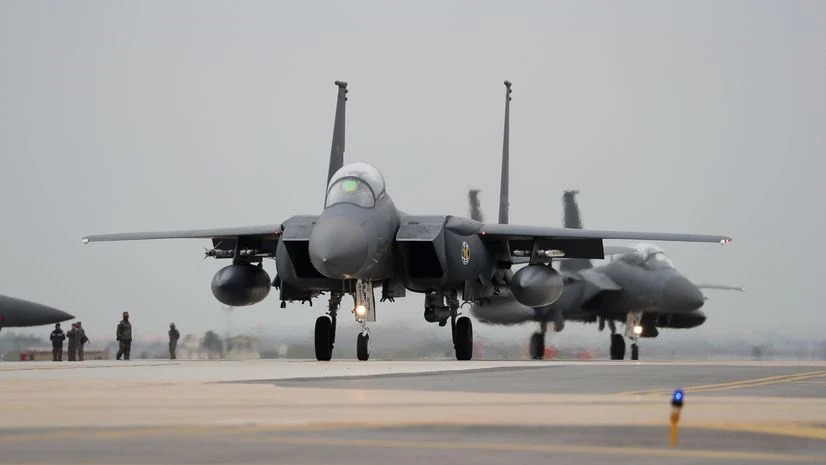Published
9 months agoon

A tragic midair collision between an American Airlines regional jet and a U.S. Army Black Hawk helicopter has resulted in a crash over the Potomac River near Reagan Washington National Airport. The Federal Aviation Administration (FAA) confirmed the incident, prompting an urgent search-and-rescue operation.
The Collision and Immediate Response
According to a source with knowledge of the situation, one or both aircraft may have plunged into the river. Emergency responders, including personnel from the Metropolitan Police Department and D.C. Fire and EMS, are actively coordinating efforts to locate and rescue survivors.
The American Airlines Bombardier CRJ700 jet, en route from Wichita, Kansas, was carrying 60 passengers and four crew members at the time of the crash. The aircraft, which has a 65-seat capacity, is configured with 44 seats in the main cabin, 12 in the extra section, and nine in first class.
The U.S. Army confirmed that the second aircraft involved was a Black Hawk helicopter with three personnel onboard. Preliminary reports suggest no indication of foul play, criminal activity, or terrorism, according to a senior FBI official from the Washington field office. The FBI remains on standby to assist in the ongoing investigation.
)
How Could This Collision Have Happened?
Despite well-documented air traffic control (ATC) procedures and flight paths, midair collisions can occur due to multiple factors, including human error, miscommunication, or technical malfunctions.
Airspace Overlap and Traffic Congestion: The proximity of Reagan National Airport to restricted airspace and military operations means that civilian and military aircraft often operate in close quarters. If the helicopter had been conducting training exercises or responding to a mission, its flight path might have intersected with commercial air traffic corridors.
ATC Coordination Issues: Air traffic controllers are responsible for maintaining safe separation between aircraft. If there was a miscommunication between the control tower and either aircraft, an unintentional entry into the same altitude or flight path could have led to the crash.
Pilot Visibility and Awareness: Helicopters and jets operate at different speeds and flight altitudes, which can create challenges in visibility and reaction time. If one or both aircraft were maneuvering under reduced visibility conditions, it might have limited their ability to detect and avoid each other.
Equipment Malfunction or Navigation Errors: Flight control systems, radar, and collision avoidance technology play crucial roles in preventing midair incidents. A potential technical failure or misreading of instruments could have contributed to the aircraft unknowingly converging on the same flight path.
Harsh Conditions Hinder Rescue Efforts
Authorities have raised concerns over the extreme water temperatures in the Potomac, recorded at 35 degrees Fahrenheit. At such temperatures, an individual exposed to the cold could lose consciousness within 15 to 30 minutes, making immediate rescue efforts critical.
Despite multiple distress calls and eyewitness reports, officials have yet to confirm any casualties. However, the urgency of the situation has mobilized multiple agencies to work in tandem to assess the wreckage and locate possible survivors.
White House Reaction
President Donald Trump addressed the nation, expressing condolences and acknowledging the severity of the crash.
Trump stated that he has been on the terrible accident that took place at Reagan National Airport, adding, may god bless their souls.
The statement, shared by White House Press Secretary Karoline Leavitt on X (formerly Twitter), also conveyed Trump’s appreciation for first responders. He assured the public that further details would be provided as the situation develops.

Another Tragic Crash…
Tonight’s midair collision over the Potomac River brings back chilling memories of a similar aviation disaster that occurred 43 years ago in the same frigid waters.
On January 13, 1982, Air Florida Flight 90 crashed into the 14th Street Bridge before plunging into the ice-covered Potomac River shortly after takeoff from Washington National Airport, now known as Reagan National Airport. Of the 79 passengers and crew members aboard the Boeing 737-200, 74 lost their lives. Additionally, four people on the bridge perished as a result of the crash.
Investigators later determined that the probable cause of the crash was the flight crew’s failure to engage the aircraft’s engine anti-ice system during ground operations in snowy conditions. The National Transportation Safety Board (NTSB) also noted that the flight captain missed critical irregularities in engine performance before takeoff—warning signs that might have prevented the catastrophe had proper protocols been followed.
The Air Florida tragedy became a turning point in aviation safety, leading to critical reforms in winter weather flight operations. The Federal Aviation Administration (FAA) acknowledges that this disaster prompted sweeping changes in pilot training, de-icing procedures, and overall winter flight safety measures, shaping the protocols that airlines follow to this day.
The Last Bit



Arizona Plane Crash Kills Two—Is the U.S. Aviation Sector Struggling? Why Are So Many Planes Crashing?


The American Airlines Crash, Is Trump Trumpeting A Wrong Narrative—From California Wildfires To The Aviation Disaster, Is Blaming DEI For Everything Justified?


The Bloody New Year’s Attack In New Orleans. What Drove Shamsud-Din Jabbar To Commit This Atrocity, And Why Car Ramming Is Increasingly Being Adopted As Acts Of Terror?


The Chilling Murder Of Brian Thompson. What We Know About The CEO’s Death And The Mystery Suspect On The Run


Why Did Trump 2.0 Tap Kash Patel To Lead The FBI. Loyalty, Distrust, And A Shared Mission?